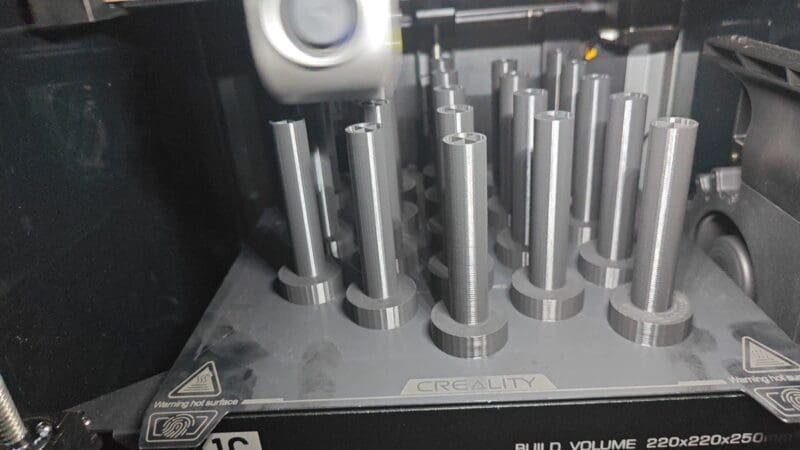Creality CR-Scan SE vs Ferret vs Ferret Pro

In the dynamic field of 3D printing and modeling, the precision and quality of your scans are pivotal. The CR-Scan Ferret series stands out as a beacon of innovation, offering a range of scanners tailored to diverse needs. This article will dissect the specifications, features, and use cases of the CR-Scan CR-Scan SE vs Ferret vs Ferret Pro models, providing a granular comparison to guide your purchase.
CR-Scan SE vs Ferret vs Ferret Pro
CR-Scan Ferret Series at a Glance
| Feature | CR-Scan Ferret SE | CR-Scan Ferret | CR-Scan Ferret Pro |
|---|---|---|---|
| Price | $259 | $329 | $429 |
| Compatibility | Mac, Windows | Mac, Windows, Android | Mac, Windows, Android, iPhone |
| Battery Grip | No | 4500mAh | 5000mAh |
| Accuracy | 0.1mm | 0.1mm | 0.1mm |
| Resolution | 0.16mm | 0.16mm | 0.16mm |
| Capture Range | 560x820mm@700mm | 560x820mm@700mm | 560x820mm@700mm |
| Frame Rate | Up to 30 fps | Up to 30 fps | Up to 30 fps |
| Outdoor Scanning | Yes | Yes | Yes |
| Alignment | Geometries/Marker/Texture | Geometries/Marker/Texture | Geometries/Marker/Texture |
| Connectivity | USB 3.0/2.0 | USB 3.0/2.0 | USB 3.0/2.0, Wi-Fi |
| Where to buy | Creality Store Amazon | Creality Store Amazon | Creality Store Amazon |
Platform Compatibility: Ensuring Seamless Connection
Understanding the importance of cross-platform support, the CR-Scan Ferret series has prioritized compatibility. All three models offer robust support for Mac and Windows users, but the Ferret and Ferret Pro extend their reach to Android devices. The Pro version goes further, embracing iPhone users with open arms, starting with the iPhone 11 and newer. This inclusivity ensures that no matter your preferred device, there’s a Ferret scanner that can integrate seamlessly into your workflow.
Scanning Efficiency: Merging Power with Precision
A key aspect of 3D scanning is the balance between the device’s power and its scanning precision. The Ferret Pro boasts the highest battery capacity at 5000 mAh, followed by the Ferret at 4500 mAh, while the SE model opts out of a battery grip and is designed for stationary, continuous use. Across the board, each model impresses with a 0.1mm accuracy and a 0.16mm resolution, ensuring that from the intricate grooves of a gear to the sweeping curves of a sculpture, every detail is captured with utmost precision.
Core Scanning Capabilities: Detail at Every Degree
Consistency is key, and the CR-Scan Ferret series does not disappoint. Each scanner offers a single capture range of 560820mm at 700mm, and a working distance of 150-700mm. The minimum scanning size remains uniform at 5050*50mm across the series, ensuring that no matter the object’s size, the scan will capture every detail. A consistent frame rate of up to 30 fps across all models translates to swift and smooth scanning processes, making the Ferret series suitable for both rapid prototyping and detailed archival work.
Adaptability and Environment: Versatile Scanning Solutions
Whether in a studio or on-site, adaptability is crucial. The Ferret series scanners are equipped for outdoor scanning, thanks to their robust design and technology. Alignment is achieved through geometries, markers, and textures, which is crucial for stitching together multiple scans into a single, coherent model. This versatility is especially beneficial for architects, artists, and engineers who require accurate scans in a variety of environments.
Workflow Integration: Data and Connectivity
In today’s digital age, the management of scan data and connectivity options are significant factors. Each Ferret model supports OBJ and STL/PLY output formats, with color texture support, ensuring compatibility with a wide range of 3D modeling software. The Ferret Pro enhances workflow efficiency with Wi-Fi connectivity, allowing for a cable-free scanning experience, while the SE and standard Ferret maintain a reliable USB 3.0/2.0 connection.
Detailed Feature Breakdown: Comparing the CR-Scan Ferret Models
Let’s dive deeper into the specifics:
Software and Hardware Compatibility:
- CR-Scan Ferret SE: The entry-level model supports Mac and Windows.
- CR-Scan Ferret: Adds Android support, catering to a broader user base.
- CR-Scan Ferret Pro: Encompasses the widest range of compatibility, including iPhones.
Battery Life and Mobility:
- CR-Scan Ferret SE: Designed for a stationary setup, it omits a battery grip.
- CR-Scan Ferret: The mid-tier option provides a battery grip for on-the-go scanning.
- CR-Scan Ferret Pro: Offers the longest battery life for extensive, uninterrupted use.
Precision and Resolution:
- All models shine with the same high precision and resolution, ensuring that your scans are accurate replicas of your physical objects.
Environmental Versatility:
- Outdoor Scanning: All models are adept at outdoor scanning, a testament to their rugged design.
- Alignment Technology: The use of advanced alignment methods guarantees that scans are accurate and ready for digital manipulation.
Connectivity and Data Handling:
- USB Connectivity: The SE and Ferret provide robust and speedy data transfer via USB.
- Wi-Fi Option: The Pro version stands out with its Wi-Fi capability, allowing for immediate transfer to connected devices.
Closing Thoughts: Finding Your Fit in the Ferret Family
As we’ve dissected the CR-Scan Ferret series, it’s evident that each model has been crafted with user needs in mind. From the versatile and powerful Ferret Pro to the efficient and precise Ferret SE, each scanner brings something unique to the table. Consider your specific 3D scanning needs—be it for industrial design, cultural preservation, or personal projects—to identify the model that aligns best with your objectives.

DISCLOSURE: THIS POST MAY CONTAIN AFFILIATE LINKS, MEANING I GET A COMMISSION IF you DECIDE TO MAKE A PURCHASE THROUGH MY LINKS, AT NO COST TO YOU. PLEASE READ MY DISCLOSURE FOR MORE INFO.















